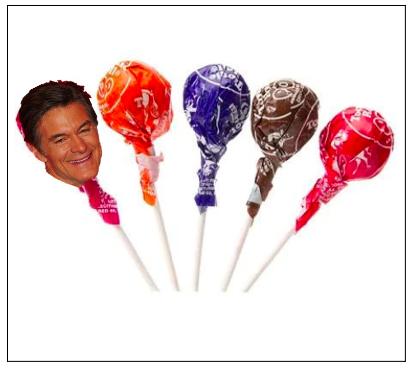Never let it be said that we at ACSH aren't at the forefront of indispensable science and medical news. Here's an item that all other science organizations badly missed. They can eat our dust. Or a Tootsie Pop, which, depending on the flavor, may be considerably tastier.
For those who may have shortcomings in their confectionery acumen, there are five basic flavors of Tootsie Pops: Grape, cherry, orange, raspberry, and chocolate. (There are also a bunch of stupid gimmicky flavors like Wild Mango Berry that are beneath my dignity to discuss.) Pffft.
Which flavor Tootsie Pop is most natural?
Since "natural everything" is now a life mandate, let's take a look at these five gourmet delicacies and see if perhaps you can extend your life by 0.00001 seconds by simply switching flavors.
1. The labels aren't much help

The ingredients label from a five-flavor bag of assorted Tootsie Pops is a composite of all ingredients for all flavors. Basically useless.
So it's time for a deep dive

There are no sacrifices I won't make for ACSH. Photo is from Providenciales, Grand Turk.
To solve this tantalizing problem, it is essential to dig deeper and look at and analyze the artificial and natural flavors in each Pop. To reach statistical significance, I solved an equation and found that I needed to eat 1,400 Pops. (OK, that's a blatant lie. My math skills are SO bad that I would have trouble solving even this equation: X = 2. Solve for X.)
You might expect few deleterious effects from consuming 1,400 Pops. You would be right.

The J-Man having both a bad hair and bad mouth day. Was briefly used as my Match.com profile photo. Didn't work all that well. Image: Wikimedia Commons
Today's big question: Which Tootsie Pop flavor is the most natural?
- Cherry Tootsie Pops taste like ass
It is no coincidence that if you're rummaging around in an open bag of Tootsie Pops that the bag will almost always (p = 0.001) contain nothing but bright red wrappers, signifying that Cherry Tootsie Pops, the dregs of the confectionery universe, has gone untouched, long after the other flavors are gone. Is this because the little monstrosities don't really taste like cherry?
Cherry flavors (Natural)
Here are the principal chemicals that make up the natural cherry flavor, with a few highlighted.

Source: James Kennedy
- Cinnamic aldehyde (cinnamaldehyde) is one of the key chemicals that gives cinnamon (duh) its flavor
- Eugenol is also called "oil of cloves." Your dentist uses it on a cotton ball to pack into cavities.
- Linalool is found in many plants, but at low concentrations, it smells like lavender.
- Benzaldehyde is the primary flavor of almonds.
Cherry flavors (Artificial)
The artificial cherry flavor is primarily benzaldehyde, and it doesn't smell like cherries; it smells like almonds. If you don't like the flavor of almonds, you're not going to like artificial cherry – one of the vilest substances on Earth IMO. Amusing aside: The chuckleheads at the Environmental Working Group actually have rated cherry Tootsie Pops! They don't much care for them (1):

EWG apparently believes that Cherry Flavor Tootsie Pops are a step or two below a lethal injection. Image: Idiot Environmental Working Group
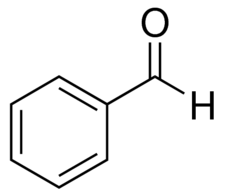
The chemical structure of benzaldehyde.
Verdict
Cherry-flavored Tootsie Pops are not even close to natural. It is unknown whether this is why they taste like ass. Grade: C-
- Grape – Delicious in a grotesque sort of way
The story of the isolation of natural grape flavor is intriguing. In the 19th century, chemists isolated a chemical called methyl anthranilate from orange blossoms. Oddly, when purified, it smelled a little like grapes, but in an icky artificial way. Thirty years later, the same chemical was found in real grapes, but only in certain varieties. Purple Concord grapes contained methyl anthranilate, but other grapes, white and red, grown in Chile and California do not. So, depending on where you lived a century ago, "artificial" grapes either tasted like real grapes or some mutant concoction vaguely reminiscent of them.
And not without reason. There are 67 known aroma chemicals in grapes, methyl anthranilate being one of them.
Verdict:
Let's call grape Tootsie Pops "marginally natural" because of the presence of a real grape chemical but the absence of many more. Grade: C+
- Orange - Sickeningly sweet. Otherwise OK
More than 40 chemicals have been detected in navel oranges. But, like artificial grape, one of these, octyl acetate, is the chemical used to give artificial orange flavor its flavor and scent. And like grape, the shell of an orange Tootsie Pop will have a recognizable orange taste, but it won't taste like a real orange.
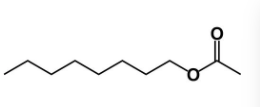
The chemical structure of octyl acetate.
Verdict
The orange in orange Tootsie Pops is about as natural as the grape in the grape Pops. But the grape tastes better.
Grade: C+
4. Raspberry - This is where things get interesting
The components of raspberry, both artificial and natural, are of particular interest. You'll see why in a moment. First, consider the following ([my emphasis]:
Raspberry flavoring may contain concentrated extracts of juice, essential oils, imitation raspberry flavor, primarily 4-(4-Hydroxyphenyl)butan-2-one, [aka] raspberry ketone, and any number of other flavorants to enhance the desired outcome. These may or may not include castoreum.
Source: Culinary Lore
Does raspberry ketone sound vaguely familiar? If so, this is probably why:
Raspberry Ketone Touted as Miracle Fat-Burner by Dr. Oz (2012)
"The number one miracle to burn your body fat."
From a Yahoo News article, Dr. Oz hails raspberry ketone as a weight-loss miracle:
But, just 100mg of [raspberrry ketone] per day is enough to get your body burning fat the way you want it to."
(Originally on the Oz site. No longer. The link will now take you to has campaign site and ask you for money.)
This last one really stung...
"I don't get why you need to say this stuff because you know it's not true...The scientific community is almost monolithic against you in terms of the efficacy of the three products you call miracles."
- Senator Claire McCaskill, Chair Senate subcommittee on consumer protection
Senator McCaskill, was referring to Oz's praise for green coffee extract, raspberry ketone, and garcinia cambogia as weight loss products.
Oz's answer wasn't entirely satisfactory:
"My job, I feel, on the show is to be a cheerleader for the audience when they don't think they have hope and they don't think they can make it happen...It jump-starts you. It gives you the confidence to keep going."
Kill me.
While I'd just love to interview Oz about raspberry ketones this is highly unlikely. The man almost certainly despises me based on some of my not-so-polite critiques in the past. In fact, back in 2014, he tried to get me on his show to sandbag me by pretending to want to discuss some pesticide! But ACSH wasn't falling for it, and a response was necessary. See Does Dr. Oz Think I'm An Idiot? (2014).
Special treat!
An imaginary rendition of my imaginary interview with Dr. Oz
JB: Dr. Oz. You used to talk a lot about miracle raspberry ketones. Can you tell me what a ketone is?
Oz: Of course. It's one of those little hard bread cubes that are in a Caesar salad.
JB: Uh, doctor... those are croutons, not ketones.
Oz: Would you like to buy some?
How natural is artificial raspberry?
So far, approximately 250 volatile compounds have been identified in raspberries
Du, et. al, "Flavor Chemistry of Small Fruits: Blackberry, Raspberry, and Blueberry"
Yet, there is one primary flavor in artificial raspberry, and it is (you guessed it) raspberry ketone, aka 4-(4-hydroxyphenyl)butan-2-one.
Verdict
Do you see the pattern here? Grape, orange, and now raspberry all contain the most prominent natural flavor plus various other chemicals that may or may not be found in real raspberries (3).
Grade: C+ B because they are very tasty.
5. Chocolate
This one is gonna surprise you.
Although the outer shell of chocolate tastes something like something chocolate-like that has been sitting for eons in a bowling shoe, it's real chocolate. This is because, unlike the four flavors above, there is no such thing as a chemical that mimics the flavor of chocolate. Only cacao beans can do this; they consist of a very complex and diverse combination of chemicals from the plant. It is cacao powder is the basis of all chocolate flavor. Unlike the other Tootsie artificial flavors, when chocolate tastes like good chocolate (like Swiss milk chocolate) it is because other ingredients, cacao butter, milk, vanilla, and sugar are added. These additives determine the flavor of the chocolate product that is consumed – the exact reverse of other flavors. One could make the argument that the best-tasting chocolate is the most artificial.
Verdict
Gotcha! You don't want to eat pure cacao powder. It is exceedingly bitter, tasting something like very chocolatey rat poison.
Grade: A- (A minus a half grade for the bowling shoes.)
Toosie Pops have health benefits. Seriously
Believe it or not, I consider Tootsie Pops to be healthy, but only by comparison. I have a wicked sweet tooth, and when it strikes, I can attack a Hershey's Bar (220 calories, 24 grams of sugar) or a Milky Way (260 calories, 35 grams of sugar). But consider the following:
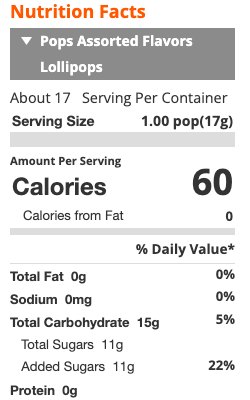
So you'd have to consume 3-4 of the damn things to equal the calories/sugar of one single candy bar. Good luck with this since a bunch of maniacs from Perdue University constructed a mechanical tongue (no salacious comments, please) that showed that it took an average of 364 licks (2) to get to the Tootsie Roll in the center, while it took nerds humans only 252 licks to hit pay dirt (no comments here either).
Why not just eat four of them?
I can make a Milky Way disappear in a minute, but the average time to consume a Tootsie Pop is 20-30 minutes. How about just chewing the Pop for more efficient sugar consumption? Before attempting this try knawing on a ball bearing for practice. Eat four? Please. Try this, and you will have expended most of the daylight and feel that you have lockjaw. Hence, the perfect candy for limiting your calories while satisfying your sweet tooth!
Or you could do organic and slurp down 11 ounces of Evolution Fresh Organic Defense Up®, although it's not entirely clear what you'll be defending yourself against (except, maybe diabetes - 37 grams of sugar!) or whether you'll actually experience evolution during the process.
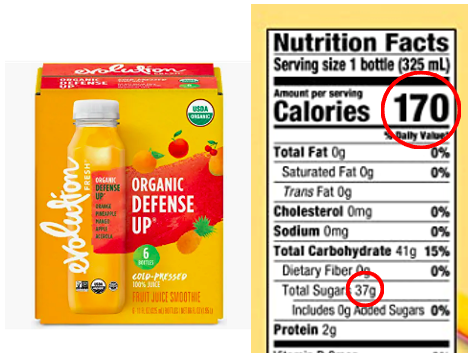
Go organic! All the way to the endocrinologist.
Summary: Which flavor Tootsie Pop is the most natural?
Chocolate >> raspberry > grape, orange > cherry.
Out of time. Gotta run. I have a Raspberry (non-magic) Tootsie Pop to conquer, and the days are getting shorter.
NOTES:
(1) Not surprisingly, the EWG doesn't care much for any Tootsie product. They all get an 8/10, a rating that should be reserved for a plutonium goulash. For some reason, the flavor only pop listed is cherry. All the others are different size Tootsie Rolls, delicious by any measure. What happened to the other 4 flavors? Who knows? The EWG chemical database is a joke, just not a very funny one.
(2) According to the literature, the number of licks to get to the center ranges from 100-1000. Don't go there.
(3) One of the other chemicals in artificial raspberry Tootsie Pops is castoreum, which is obtained from the rectal area of beavers. I'm not going here. Don't want this article to be in poor taste. (Curiously, artificial raspberry does not smell like ass.)
